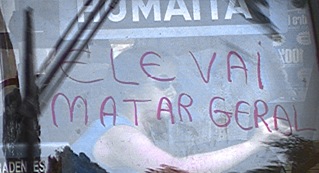2003 TOP 10 — Number 8

BUS 174 (Jose Padilha, Brazil)
This is the second of the three documentaries on my list, and what lifts all three films is that there’s more there than mere reportage or the capturing of an interesting or amusing corner of The Diversity Of The American (or Brazilian) Quilt. The latter is an estimable thing of course, and can make for an enjoyable couple of hours. But BUS 174 is much more.
On the surface, it’s a police procedural, recounting the June 2000 hijacking of a Rio De Janeiro bus by a former street child that gets botched by both the police and the perpetrator and so turns into a hostage situation and then worse on national TV (think the OJ-Bronco chase). Because all of Brazil was on the edge of its seat for five hours of an afternoon and evening over the “Bus 174 Hijacking” and the police never set up a security perimeter around the vehicle as it stood at the Rio bus stop, the footage of the crime-in-progress is … incredible, unbelievable. You never overcome your amazement that this footage exists.
 So Padilha starts with the greatest episode of “Cops” in history. But then he does two other things: 1) he meticulously reconstructs the life story of the perpetrator, named Sandro, and does so sufficiently thoroughly while weaving it into the hour-by-hour recounting of the hijacking in all the right places, so that it all seems inevitable and tragic; and 2) he demonstrates Freddy Riedenschneider Heisenberger’s Uncertainty Principle of Policing (i.e., watching a thing changes it) and all the ways it contributed to the police botching the siege. Contrary to what you might think, the Brazilian police are not shown as brutal oppressores, trigger-happy Third World gangsters with badges.
So Padilha starts with the greatest episode of “Cops” in history. But then he does two other things: 1) he meticulously reconstructs the life story of the perpetrator, named Sandro, and does so sufficiently thoroughly while weaving it into the hour-by-hour recounting of the hijacking in all the right places, so that it all seems inevitable and tragic; and 2) he demonstrates Freddy Riedenschneider Heisenberger’s Uncertainty Principle of Policing (i.e., watching a thing changes it) and all the ways it contributed to the police botching the siege. Contrary to what you might think, the Brazilian police are not shown as brutal oppressores, trigger-happy Third World gangsters with badges.
Very early on, the film makes it clear that bus and car hijackings are not rare in Rio, but are generally handled extra-judicially in one (let it pass) or another (street justice) sense. But the media circus made both impossible. It forced police into doing *something.* But it paralyzed them from doing anything in particular, partly for fear of looking like “jackboot fascists” in the wake of investigations of police brutality, including the notorious Candelaria massacre of dozens of Rio street children, and partly from micromanagement at the highest levels of Brazilian politics. (There’s also a documentary to be made about the nearly-identically botched 1980 US attempt to rescue the Embassy hostages held in Iran.)

That combination of necessity and paralysis explains why the police botched this siege *in this specific way* and how Sandro met his fate *in this specific way.* And so #2 defangs and even reverses the criticisms from some over #1 — that, by detailing his backstory, the film makes excuses for Sandro. Through this depiction of top-down chill, sent down like an Ashcroft order against racial profiling, BUS 174 actually implies all sorts of not-so-nice things about that very kind of “oh, poor misunderstood criminal who had a crappy life” discourses that #1, on the surface, represents.
Oh … and have I mentioned that BUS 174 is also formally dazzling? Two scenes take place inside Rio prisons where Sandro had been. In the first, the prison has been shut down and we see the cells where dozens of men had been crammed. In the second, we see an in-use prison, only Padilha shoots this scene entirely in reverse exposure — you’re basically looking at the film’s negative. The jail thus looks even worse than what our imagination had told us from the first scene because the inmates have been turned into an indistinct, wailing chorus trapped in a Dantean hell. Near the end, there is also a fatal shooting that we see in real-time — we go “wtf?” — and then Padilha gives it to us frame-by-frame, like the Zapruder film. And you’re on the edge of your seat as you see exactly … what … you feared … it was.
One of the saddest stats I know: this great but-in-Portuguese film, entirely accessible and not-the-least-bit arty, has made barely $100,000 in US release and has not played on more than five screens nationwide in any week. A handful of BUS 174 prints are still inching their way around the country. If it hits your town — try to catch it.
No comments yet.
Leave a comment